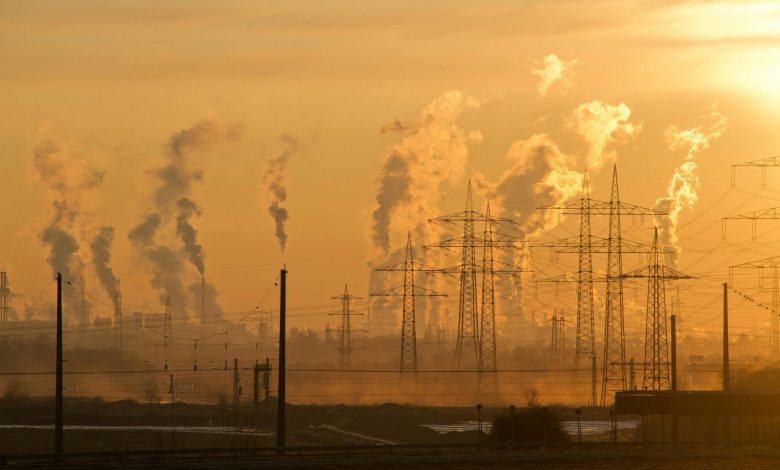Clearing the Air: Understanding the Dangers of Ground-Level Ozone

Ground-level ozone is a major component of smog and a significant air pollutant that poses serious threats to human health and the environment.
Unlike the ozone layer in the upper atmosphere, which shields the Earth from harmful ultraviolet radiation, ground-level ozone is a harmful pollutant formed through chemical reactions involving sunlight, nitrogen oxides, and volatile organic compounds.
Formation Of Ground Level Ozone
Ground-level ozone is not directly emitted into the air but forms through a complex series of chemical reactions involving sunlight and other precursor pollutants.
Here’s an easy-to-understand explanation of its formation and sources:
Formation:
The key ingredients for ground-level ozone formation are nitrogen oxides (NOx) and volatile organic compounds.
These pollutants come from various sources and undergo a photochemical reaction in the presence of sunlight.
Nitrogen oxides (NOx): These are emitted from high-temperature combustion processes, primarily from vehicles, power plants, and industrial facilities that burn fossil fuels.
Volatile organic compounds (VOCs): These are emitted from various sources, including vehicles, gasoline vapors, solvents, paints, and even natural sources like vegetation.
Sunlight:
The photochemical reactions that form ground-level ozone require energy from sunlight, specifically the ultraviolet portion of the solar spectrum.
When these three components (NOx, VOCs, and sunlight) come together in the lower atmosphere, a series of complex chemical reactions take place.
The nitrogen oxides and volatile organic compounds act as precursors, undergoing a series of reactions initiated by sunlight.
These reactions produce highly reactive molecules that combine with oxygen to form ground-level ozone.
It’s important to note that ground-level ozone formation is a non-linear process, meaning that changes in precursor levels do not necessarily result in proportional changes in ozone concentrations.
Sources:
The primary sources of ground-level ozone precursors (NOx and VOCs) include:
Transportation: Emissions from vehicles, particularly those with gasoline and diesel engines, are a major source of NOx and VOCs.
Industrial activities: Various industrial processes, such as power generation, manufacturing, and chemical production, emit NOx and VOCs.
Fuel combustion: The burning of fossil fuels for energy production, heating, and other purposes releases NOx and, to a lesser extent, VOCs.
Solvents and consumer products: Many household and commercial products like paints, cleaners, and personal care items contain VOCs that can contribute to ground-level ozone formation.
Natural sources: Some NOx and VOCs can also originate from natural sources like vegetation, soil microbes, and lightning.
It’s important to emphasize that ground-level ozone is a secondary pollutant, meaning it is not directly emitted but formed through the chemical reactions involving the precursor pollutants from various human-made and natural sources.
Health and Environmental Impacts of Ground Level Ozone
Ground-level ozone can have serious detrimental effects on both human health and the environment. Here’s an easy-to-understand and detailed explanation of its impacts:
Health Impacts
Respiratory system: Ozone is a powerful oxidant that can cause respiratory problems when inhaled. It can irritate and inflame the airways, leading to coughing, shortness of breath, and a burning sensation in the throat and chest.
Lung damage: Prolonged exposure to elevated levels of ground-level ozone can cause permanent lung damage, including scarring and reduced lung function.
Asthma exacerbation: Ozone can trigger asthma attacks and worsen existing asthma symptoms, making it harder to breathe.
Increased susceptibility to respiratory infections: Ozone exposure can weaken the body’s defenses against respiratory infections like pneumonia and bronchitis, making people more vulnerable to these illnesses.
Cardiovascular effects: Some studies suggest that ozone exposure may also contribute to cardiovascular problems, such as heart attacks and strokes, particularly in individuals with pre-existing heart conditions.
Environmental Impacts
Vegetation damage: Ground-level ozone can harm sensitive vegetation, including trees, crops, and plants. It can cause visible leaf damage, reduce photosynthesis, and stunt growth, leading to lower crop yields and decreased forest productivity.
Ecosystem effects: High ozone levels can disrupt ecosystems by affecting the health and reproduction of various plant and animal species, altering the balance of natural communities.
Climate change: Ground-level ozone is a greenhouse gas that contributes to global warming and climate change, trapping heat in the Earth’s atmosphere and exacerbating the effects of other greenhouse gasses.
Material damage: Ozone can accelerate the degradation of certain materials, such as rubber, plastics, and textiles, leading to premature aging and deterioration.
Visibility impairment: Ground-level ozone is a key component of smog, which can reduce visibility and obscure scenic views, affecting outdoor activities, potentially causing accidents and negatively impacts tourism.
The severity of these health and environmental impacts depends on the concentration and duration of exposure to ground-level ozone. Sensitive groups, such as children, older adults, individuals with respiratory conditions, and outdoor workers, are particularly vulnerable to the adverse effects of ozone pollution.
How is Ground Level Ozone Pollution Dealt With?
Ground-level ozone is monitored through air quality monitoring networks, and various regulatory efforts and standards have been established to control its levels and mitigate its impacts.
Ground-level ozone levels are monitored through a network of air quality monitoring stations established by government agencies and environmental organizations.
These stations are strategically located in urban areas, industrial zones, and other regions susceptible to high ozone levels.
The data collected from these monitoring stations is analyzed to track ozone trends, identify hotspots, and assess compliance with air quality standards.
This information is essential for informing policy decisions and developing effective mitigation strategies.
In India, the regulation and monitoring of ground-level ozone are primarily governed by the Central Pollution Control Board (CPCB) and state-level pollution control boards.
Here are some key regulatory efforts and standards related to ground-level ozone in India:
National Ambient Air Quality Standards (NAAQS):
The CPCB has established National Ambient Air Quality Standards (NAAQS) for various air pollutants, including ground-level ozone. The current NAAQS for ozone is as follows:
8-hour average: 100 μg/m³ (0.051 ppm)
1-hour average: 180 μg/m³ (0.092 ppm)
These standards are based on the guidelines provided by the World Health Organization (WHO) and are aimed at protecting public health.
Air Quality Monitoring Network:
The CPCB, in collaboration with state pollution control boards, operates a nationwide air quality monitoring network called the National Air Quality Monitoring Programme (NAMP).
This network includes monitoring stations that measure ground-level ozone concentrations across various cities and industrial areas.
The government also takes actions and creates policies to deal with pollution that can cause various issues including ground level Ozone pollution like:
Emission Norms for Vehicles and Industries:
To control the emissions of ozone precursors (nitrogen oxides and volatile organic compounds), India has implemented emission norms for vehicles and industries.
For example, the Bharat Stage Emission Standards (BSES) regulate vehicular emissions, while industries are subject to specific emission limits based on their sector and location.
Air Act and Pollution Control Laws:
The Air (Prevention and Control of Pollution) Act, 1981, and the Environment (Protection) Act, 1986, provide the legal framework for regulating and controlling air pollution, including ground-level ozone.
These acts empower the CPCB and state pollution control boards to set standards, monitor compliance, and take necessary actions to mitigate air pollution.
Action Plans and Mitigation Strategies:
In response to rising air pollution levels, including ground-level ozone, several states and cities have developed action plans and mitigation strategies.
These plans often include measures such as vehicular restrictions, promotion of public transportation, emission controls for industries, and awareness campaigns.
International Collaboration:
India is a signatory to various international agreements and initiatives aimed at addressing air pollution and climate change, such as the Paris Agreement and the United Nations Environment Programme (UNEP).
These agreements facilitate knowledge-sharing, capacity-building, and collaborative efforts to tackle air pollution issues, including ground-level ozone.
While these regulatory efforts and standards are in place, effective implementation, enforcement, and continuous monitoring remain essential to address the challenge of ground-level ozone pollution in India.





